Nervous System Resting Membrane Potential and Action Potentials
1/84
There's no tags or description
Looks like no tags are added yet.
Name | Mastery | Learn | Test | Matching | Spaced |
|---|
No study sessions yet.
85 Terms
what is a stimulus in neurophysiology?
something capable of altering the resting membrane potential
what happens if a stimulus is strong enough and reaches threshold?
action potential fires
what is voltage?
potential energy generated by separation of charge across membrane
what is current?
electrical charge between outside and inside of cell
what does current create?
voltage
what is resistance?
hindrance to charge flow
what are the two types of resistance?
insulator, conductor
what is an insulator?
substance with high electrical resistance
what is a conductor?
substance with low electrical resistance
what is ohm’s law?
current (i)=voltage/resistance
what type of relationship does the current and resistance have?
inverse relationship
what type of relationship does current and voltage have?
direct relationship
what is membrane potential?
difference of charge across a membrane
what is resting membrane potential?
-70 mV
describe the resting membrane potential
polarized, negative inside cell, positive outside
how is the resting membrane potential maintained?
leak channels, sodium potassium pump
how do leak channels maintain the resting membrane potential?
sodium and potassium move down their concentration gradients, sodium in, potassium out
how does the sodium potassium pump maintain the resting membrane potential?
3 sodium pumped out of cell, two potassium pumped in
what are the membrane ion channels?
leak, chemically (ligand) gated, voltage gated
which membrane ion channel is always open?
leak channel
what are gated membrane ion channels?
protein changes shape to open or close channel
what are chemically (ligand) gated channels?
channels that open with binding of a specific neurotransmitter
what are voltage gated channels?
channels that open and close in response to changes in membrane potential
what each Na+ channels have?
two voltage-sensitive gates
what are the two-voltage sensitive gates for sodium channels?
activation and inactivation gates
which gates are closed at rest and open with depolarization?
activation gates
during activation, what does depolarization allow for?
sodium to enter cell
what gates are open at rest and block channels once it is open to prevent more sodium from entering cell?
inactivation gates
what does each potassium channel have?
one voltage sensitive gate
which channel is closed at rest and opens slowly with repolarization?
potassium channels
what is depolarization?
decrease in membrane potential
what happens to the inside of membrane during depolarization?
more positive than resting membrane potential
what is hyperpolarization?
an increase in membrane potential
what happens to the inside of the cell during hyperpolarization?
becomes more negative than resting membrane potential
what does hyperpolarization reduce?
probability of producing a nerve impulse
when does membrane potential change?
concentration of ions across membrane change, membrane permeability to ions changes
what causes change in membrane potential?
graded potentials, action potentials
what are graded potentials?
short lived, localized changes in membrane potential
how are graded potentials triggered?
stimulus that opens gated ion channels
where do action potential occur?
axon hillock
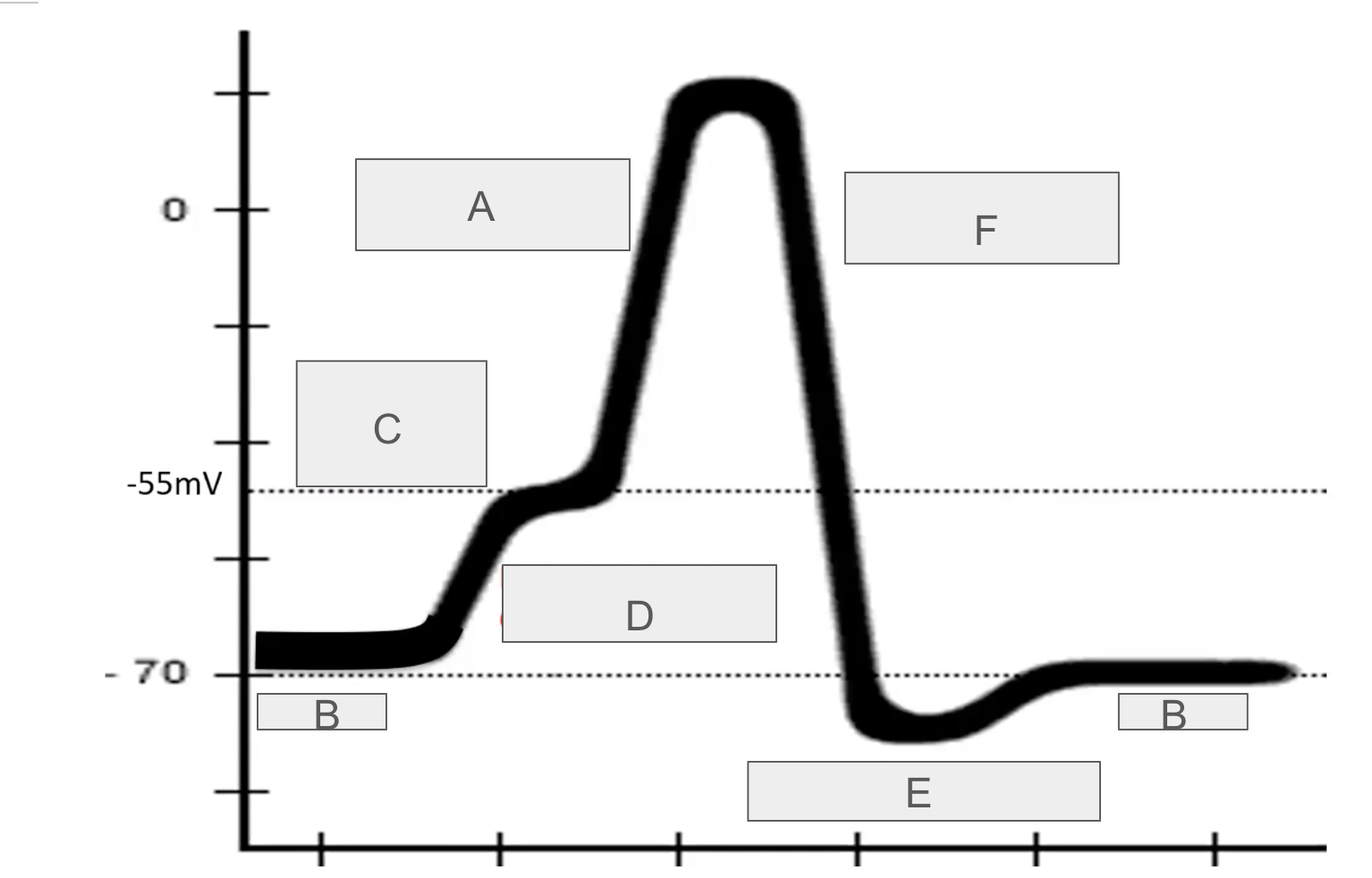
what is A?
depolarization
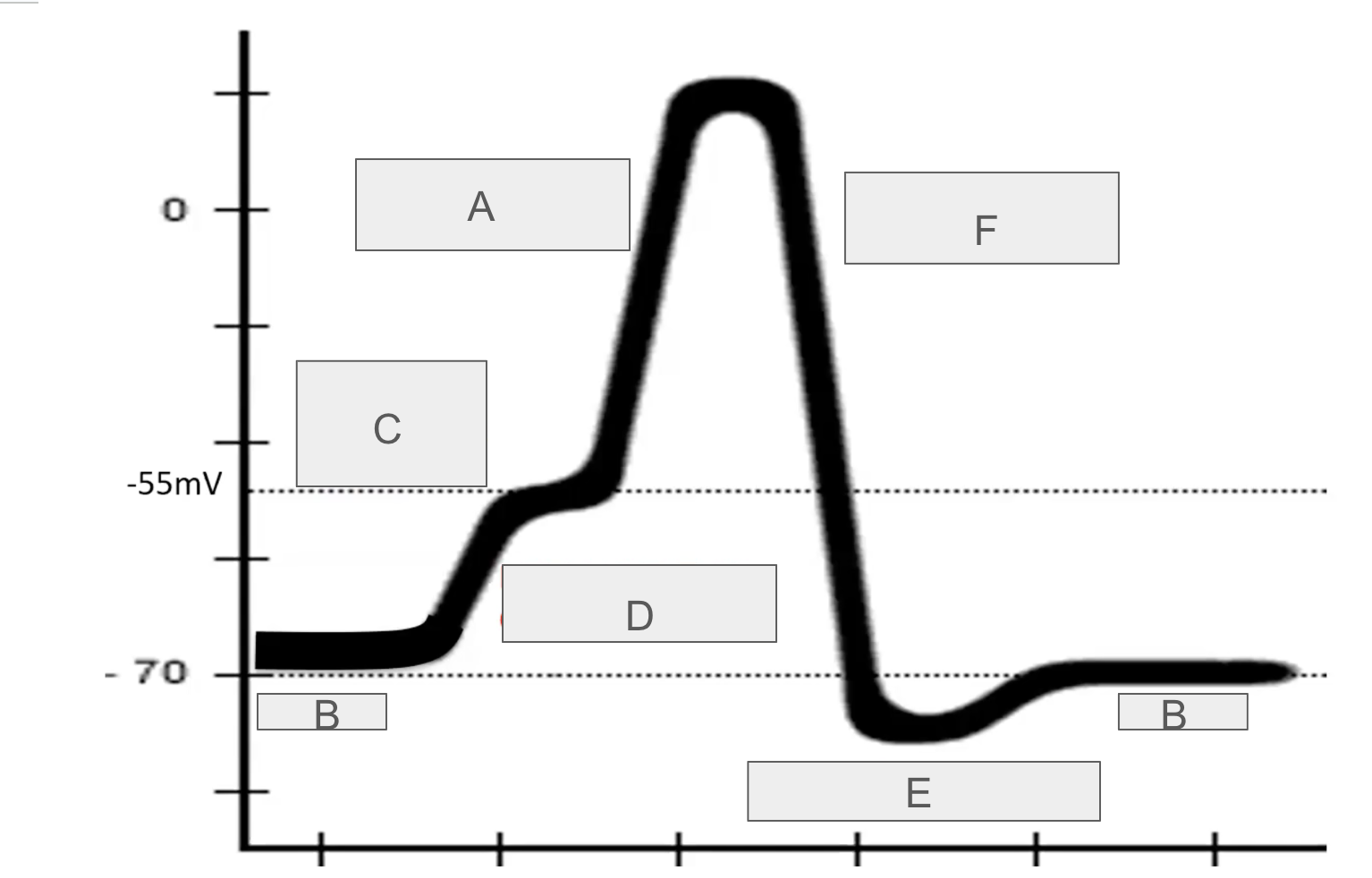
what is B?
RMP

what is C?
threshold is reached, action potential starts
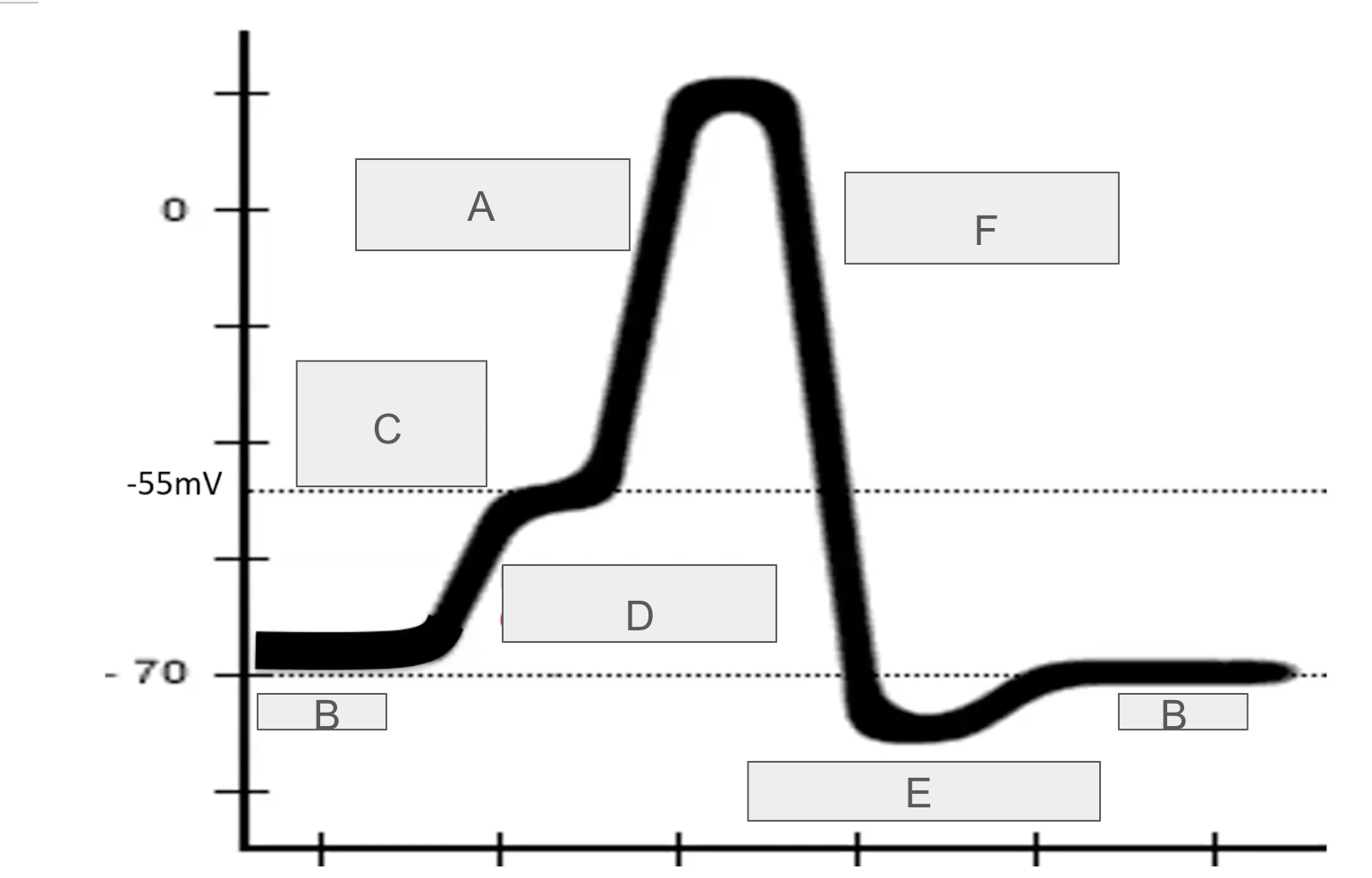
what is D?
depolarization- graded potentials
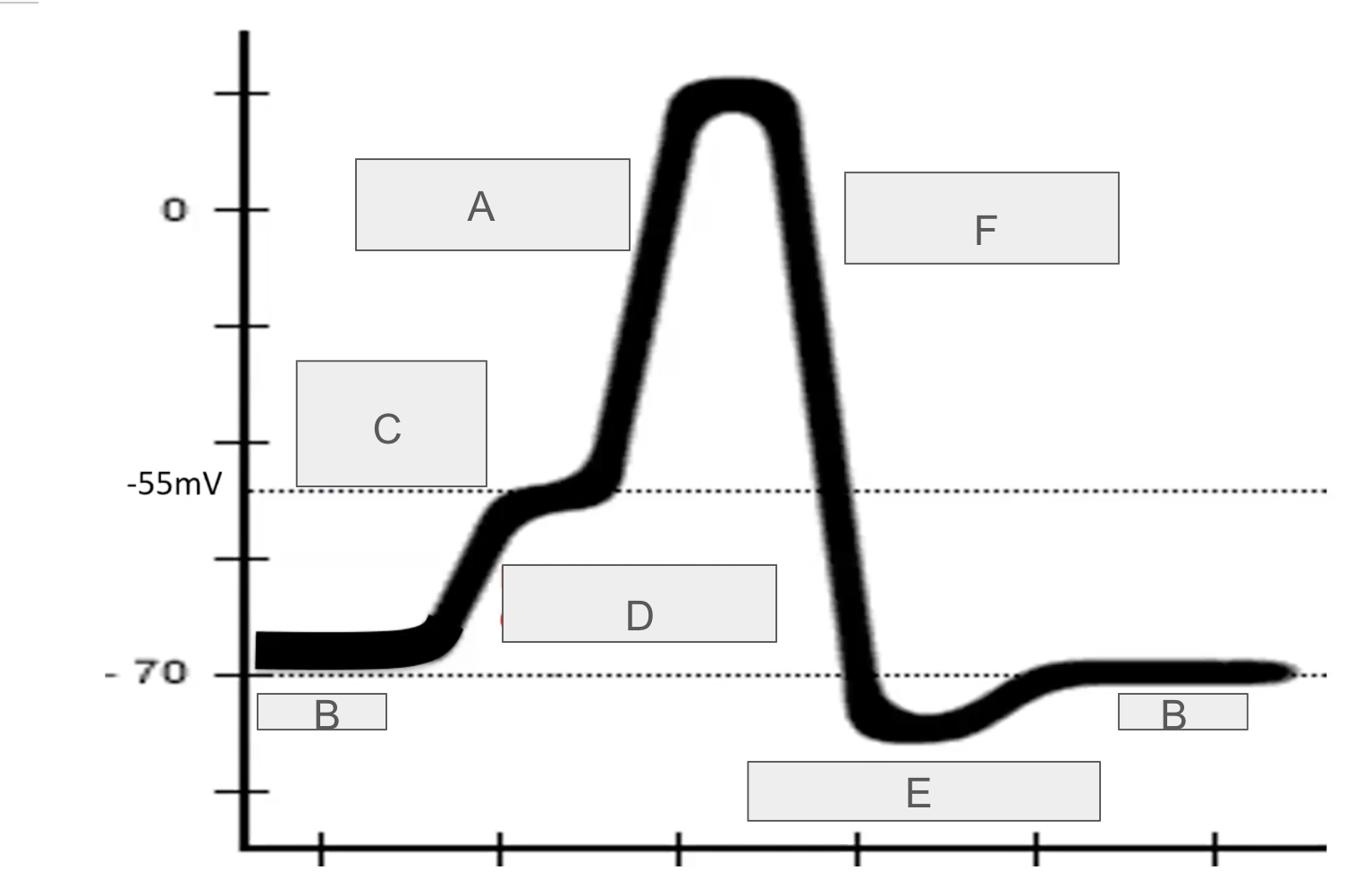
what is E?
hyperpolarization
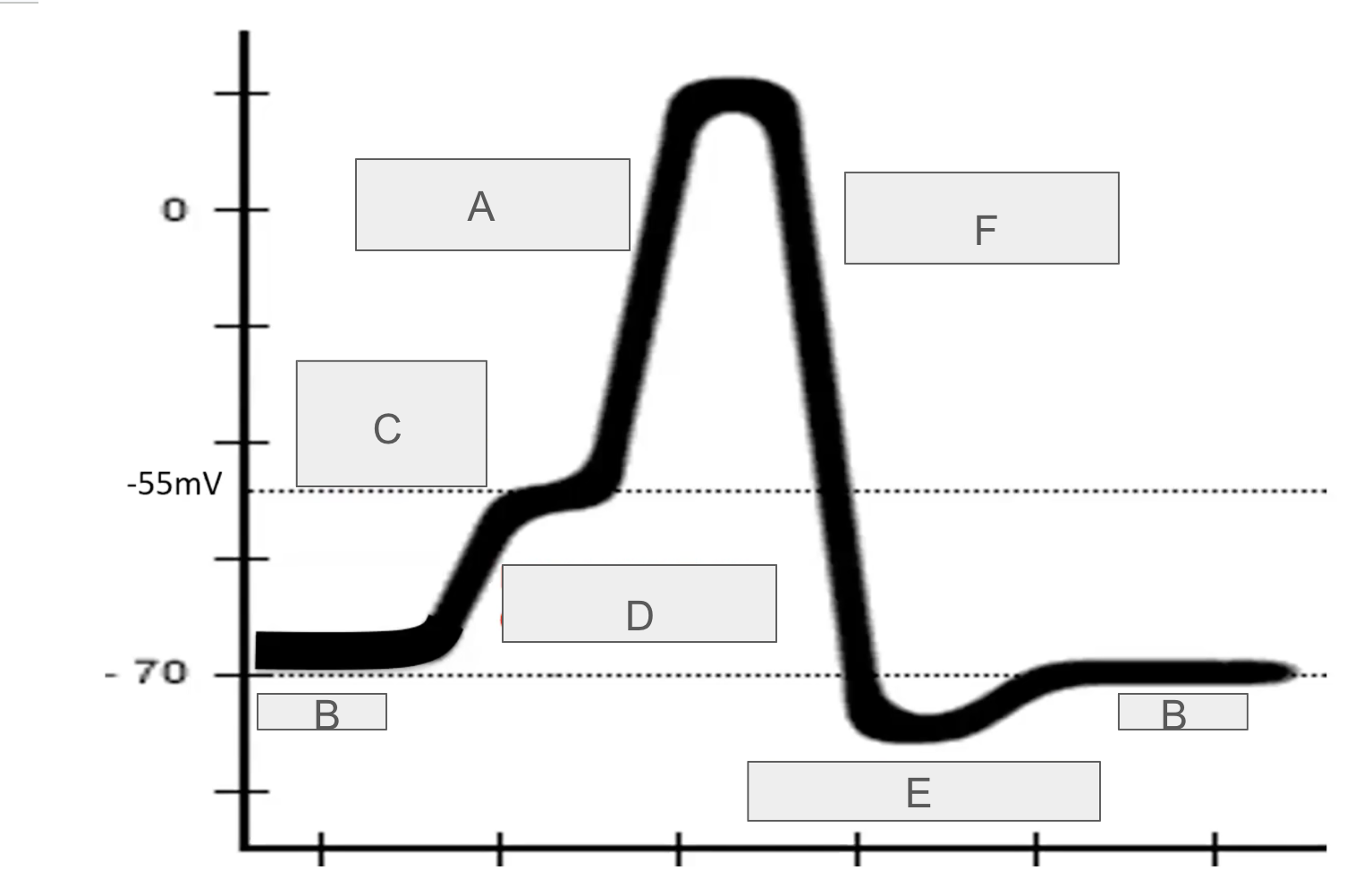
what is F?
hyperpolarization
describe the sodium and potassium channels at the resting membrane potential
sodium channels are open but active, potassium channels are closed
at what membrane potential will action potential free?
action potential will fire
how do graded potentials reach threshold?
summation
what happens to sodium once the threshold is met?
sodium channels open, sodium rushes in
describe the sodium and potassium channels during depolarization
sodium channels are open and active, potassium channels are closed
describe the sodium and potassium channels at the peak?
sodium channels are closed and inactive, potassium channels are open
describe the sodium and potassium channels during repolarization?
sodium channels are open and inactive, potassium channels are open
what is the relative refractory period?
action potential can fire but needs a greater stimulus because it is now farther from threshold
describe the sodium and potassium channels during hyperpolarization?
sodium channels are closed and active, potassium channels are open but closing
what is the all or non phenomenon?
an action potential either happens completely or it does not happen at all
what does the influx of sodium cause?
local currents
what do local currents cause?
depolarization of adjacent membrane areas in direction away from action potentials origin, toward axon’s terminals
what are the types of refractor periods?
absolute refractory period, relative refractory period
what does it mean when a muscle is in the absolute refractory period?
absolutely no action potentials can be fired
what does it mean when a muscle is in the relative refractory period?
only a very strong stimulus could stimulate an action potential
when does the absolute refractory period begin?
time from opening of sodium channels until resetting of the channels
what does the absolute refractory period ensure?
that each action potential is an all-or-none event
what does the absolute refractory period enforce?
one way transmission of nerve impulses
when does relative refractory period occur?
when most sodium channels have returned to their resting state, some potassium channels are still open
what is happening during the relative refractory period?
hyperpolarization
how does the central nervous system tell the difference between a weak and strong stimulus?
strong stimuli cause action potentials to occur more frequently
how does the central nervous system determine stimulus intensity?
frequency of the impulses
what does the rate of action potential propagation depend on?
temperature and pressure, axon diameter, degree of myelination
how does temperature affect the rate of action potential propagation?
warmer temperature = faster
how does axon diameter affect the rate of action potential propagation?
larger diameter fibers have less resistance to local current flow so faster impulse conduction
how does the degree of myelination affect the rate of action potential propagation?
continuous conduction in nonmyelinated axons is slower than saltatory conduction in myelinated axons
why does cold temperature and increased pressure decrease blood flow?
decreases supply of oxygen and nutrients, decreases ability to conduct electrical impulses
which fibers are faster, large, myelinated, have a short absolute refractory period, and sense danger?
A fibers
which fibers are slower, smaller, myelinated, have longer absolute retraction periods?
B fibers
which fibers are slowest, smallest, unmyelinated, and have the longest absolute retraction period?
C fibers
what role do myelin sheaths play in action potentials?
myelin sheaths insulate and prevent leakage of charge
what does myelination allow for?
salatory conduction
why is conduction slow in nonmyelinated axons?
because it takes time for ions and gates to move
why is conduction in myelinated axons fast?
action potentials are generated only in myelin sheath gaps and appear to jump rapidly from gap to gap
what are the advantages of saltatory conduction?
less energy expended by sodium potassium pump to reset resting membrane potential, increases speed of conduction
what is multiple sclerosis?
autoimmune disease affecting primarily young adults
what is destroyed in multiple sclerosis?
myelin sheaths in central nervous system
what are symptoms of multiple sclerosis?
visual disturbances, weakness, loss of muscle control, speech disturbances, urinary incontinence, cognitive decline
what are treatments for multiple sclerosis?
drugs and dietary changes